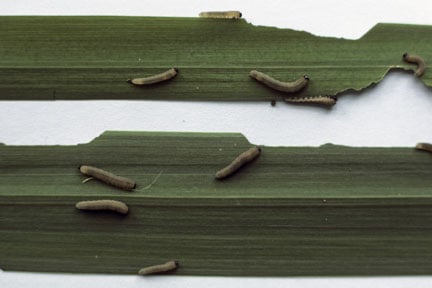
Quick facts
Common name - Iris sawfly
Scientific name - Rhadinoceraea micans
Plants affected - Flag iris (Iris pseudacorus) and other waterside irises
Main symptoms - The foliage is eaten by greyish-brown caterpillar-like larvae
Caused by - Larvae of a sawfly
Timing - April-July
What is iris sawfly?
Sawflies are in the same group of insects as bees, ants and wasps (the Hymenoptera). They have caterpillar-like larvae that feed on plants whilst the adults are winged insects that can appear fly-like. More than 500 species of occur in Britain, you can find out more about these insects from British and Irish Sawflies.
Iris sawfly has greyish-brown larva that reach 25 mm in length and eat the foliage of flag iris (Iris pseudacorus) and other waterside irises, including Irisspuria, I. versicolor, I. laevigata and I. ensata. The adults are similar in appearance to some other species of sawfly and have black heads and bodies up to 8 mm long with smoky grey wings.
Symptoms
Iris larvae can feed in groups so damage can occur very quickly and defoliation can be extensive.
- Greyish-brown caterpillar-like larvae with whitish spots brown heads and up to 25 mm long
- Initially V-shaped notches from the leaf margins but later devour the foliage from the leaf tips downwards
- Plants can be completely defoliated, affecting appearance
- Complete defoliation tends not to occur every season and plants can recover

Management
Sawflies are a part of the a healthy garden supports.
- Where possible tolerate populations of iris ; iris plants can recover
- Encourage predators and other natural enemies of sawfly in the garden, such as birds, wasps and ground beetles
- Regularly inspect plants during the growing season
- Remove by hand if required and where practical
Biology
Iris adults are active in late April-May and soon lay eggs on the foliage of host plants. The greyish-brown caterpillar-like larvae, speckled with small white spots and up to 25 mm long, are present in June-July. The larvae initially eat V-shaped notches from the leaf margins but later devour the foliage from the leaf tips downwards.
There is one generation a year and larvae overwinter in the soil before pupating the following spring.











